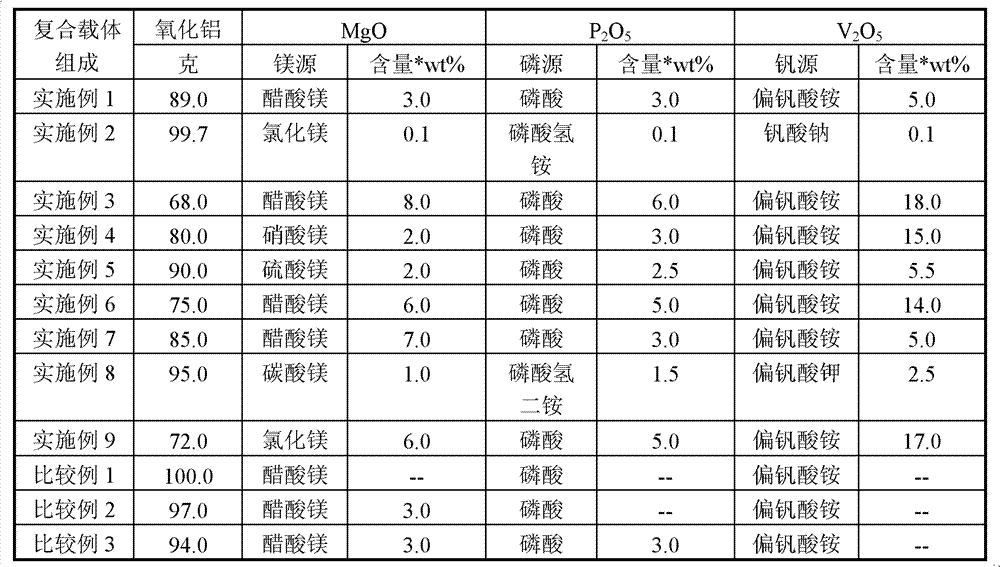Selective hydrodesulfurization method of light cycle oil
A light cycle oil, hydrodesulfurization technology, applied in the petroleum industry, hydrocarbon oil treatment and other directions, can solve the problems of large loss of aromatics, low hydrogenation selectivity, etc., to improve comprehensive performance, improve desulfurization, and improve mutual synergy effect of action
- Summary
- Abstract
- Description
- Claims
- Application Information
AI Technical Summary
Problems solved by technology
Method used
Image
Examples
Embodiment 1
[0029] Preparation of the composite carrier: A: take 200 grams of boehmite; B: take 40 grams of water, add 10.0 grams of 1:1 nitric acid, mix and dissolve evenly. Slowly add B into A and stir evenly, knead for 40 minutes, extrude and dry at 100-130°C for 3 hours, and bake at 500°C for 2 hours to obtain γ-Al 2 o 3 Forming carrier 1. Get molding carrier (I) 89 grams and contain 5.00% V by weight percentage 2 o 5 Immerse in 80 grams of ammonium metavanadate aqueous solution, dry at 100-130°C for 3 hours, and roast at 590°C for 2 hours; Drying at ℃ for 3 hours, calcining at 550℃ for 2 hours; after calcination, the carrier is impregnated with phosphoric acid aqueous solution containing 3.75% P2O5 in weight percentage, then dried at 100-130℃ for 3 hours, and calcined at 500℃ for 2 hours to obtain a composite carrier. See Table 1 for sources of raw materials.
[0030] Catalyst preparation, take 100 grams of composite carrier, prepare the catalyst by impregnation method, prepare ...
Embodiment 2-9
[0033] The preparation method of the composite carrier is exactly the same as that in Example 1, except that the concentration of the impregnating liquid raw materials used in the preparation of the composite carrier is different, and the changed conditions are shown in Table 1. The preparation method of the catalyst is exactly the same as that of Example 1, except that when the active component is NiO or CoO plus NiO, the cobalt salt in the impregnation solution is partially or completely replaced by nickel salt, and the amount of the active group loaded on the composite carrier is The difference, see Table 2 for details.
[0034] Table 1
[0035]
[0036] *Amount of oxide in the composite support in percent by weight.
[0037] Table 2
[0038] active ingredient
Embodiment 10~15
[0048] The catalyst of Example 4 is selected, and the results in Table 4 of different sulfur content LCO raw materials and different evaluation conditions are listed in Table 5.
[0049] Table 4
[0050]
Sulfur content (ppm)
Nitrogen content (ppm)
PAH content (wt%)
Total aromatics content (wt%)
2000
350
45.5
72.6
4000
260
48.3
78.3
6000
530
52.6
80.6
raw material 4
8000
420
56.3
77.2
raw material 5
10000
760
48.7
85.3
raw material 6
15000
620
58.9
80.6
[0051] wt% means percentage by weight.
[0052] table 5
[0053]
[0054] wt% means percentage by weight.
PUM
 Login to View More
Login to View More Abstract
Description
Claims
Application Information
 Login to View More
Login to View More - R&D
- Intellectual Property
- Life Sciences
- Materials
- Tech Scout
- Unparalleled Data Quality
- Higher Quality Content
- 60% Fewer Hallucinations
Browse by: Latest US Patents, China's latest patents, Technical Efficacy Thesaurus, Application Domain, Technology Topic, Popular Technical Reports.
© 2025 PatSnap. All rights reserved.Legal|Privacy policy|Modern Slavery Act Transparency Statement|Sitemap|About US| Contact US: help@patsnap.com



